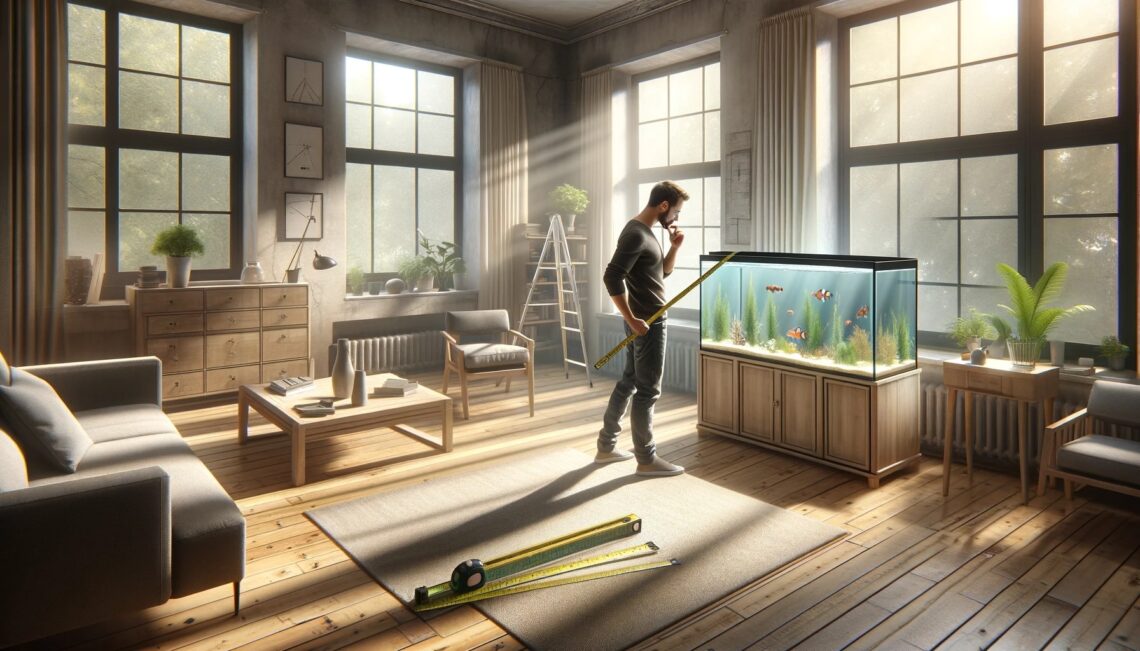If you’re new to fishkeeping and feeling overwhelmed about setting up your first fish tank, don’t worry. This simple guide is designed to walk you through the process step-by-step, ensuring that your aquatic journey is both enjoyable and successful. From selecting the right tank to introducing your new fish, we’ve got you covered.
Key Takeaways
- Selecting the Right Aquarium: Choose a tank that fits your space and meets the needs of the fish you want to keep.
- Setting Up: Follow a step-by-step process to ensure a safe and stable environment.
- Cycling: Understand the importance of cycling your tank to establish beneficial bacteria.
- Aquascaping: Create a visually appealing and comfortable habitat for your fish.
- Fish Selection: Choose compatible fish and avoid overstocking.
- Maintenance: Regularly maintain your tank to ensure the health and happiness of your fish.
- Troubleshooting: Be prepared to address common problems that may arise.
Choosing the Right Aquarium and Equipment
When I first decided to venture into the world of aquariums, I quickly realized that choosing the right aquarium and equipment is crucial for both the health of the fish and the aesthetic appeal of my home. There are many factors to consider, such as the type of aquarium (glass vs. acrylic), the size and location of the tank, and the essential equipment needed for a thriving aquatic environment.
Types of Aquariums
Glass vs. Acrylic: Both have their pros and cons. Glass aquariums are more scratch-resistant and offer a clearer view, while acrylic tanks are lighter and more impact-resistant. Understanding these differences helped me choose the right material for my space and lifestyle.
Selecting the Right Size and Location
Size Matters: The size of the aquarium depends on the type and number of fish I plan to keep. It’s important to provide ample space for fish to swim and grow. Location: A stable, level surface away from direct sunlight and heavy traffic areas is ideal. This ensures a stable environment for the fish and easy maintenance for me.
Essential Equipment
- Filter: Crucial for maintaining water quality and clarity.
- Heater: Necessary to maintain a consistent temperature, especially for tropical fish.
- Lighting: Enhances the beauty of the aquarium and is vital for the growth of plants.
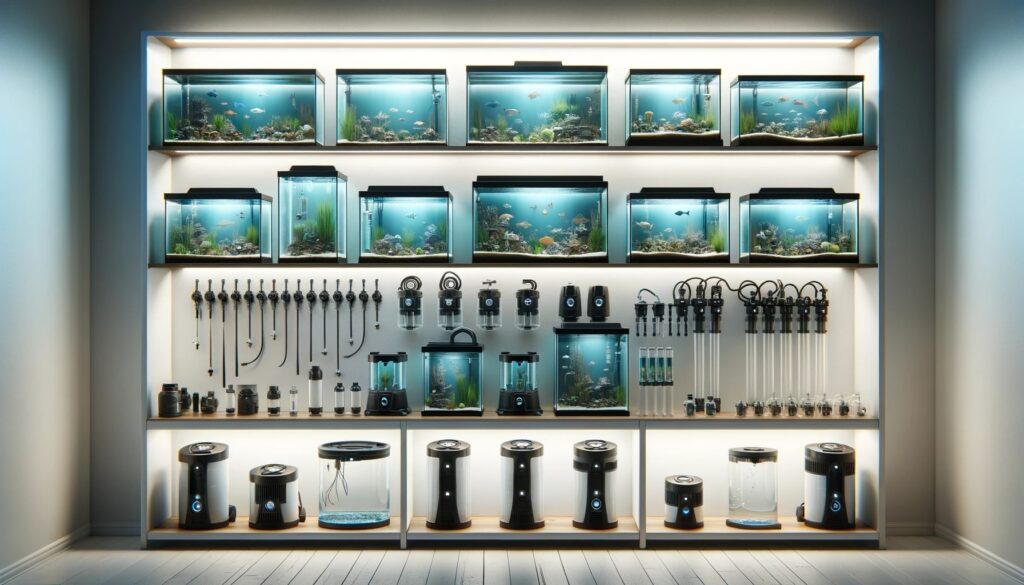
For more in-depth information on choosing the right equipment, check out these comprehensive guides on aquarium equipment.
Choosing the right aquarium and equipment is a journey that requires careful consideration and research. By understanding the different options available and assessing my own needs, I was able to create a beautiful and healthy aquatic environment. Remember, a well-planned aquarium brings not only joy to your home but also creates a nurturing space for your aquatic friends.
Setting Up Your Aquarium
I’m thrilled to share my knowledge on setting up your first aquarium. This guide will walk you through each step, ensuring you create a beautiful and safe environment for your aquatic friends.
1. Choosing the Perfect Location
First and foremost, selecting the right spot for your aquarium is crucial. It should be a stable surface, away from direct sunlight and heavy traffic areas to avoid stress to the fish and potential accidents. For more on the importance of tank placement, visit Oscar Fish Lover’s guide to tank size and placement.

2. Preparing the Substrate
The next step is adding substrate to your tank. This can be gravel, sand, or specialized aquatic soil, depending on the type of fish and plants you plan to keep. Properly rinse the substrate before adding it to the tank. Learn more about choosing and preparing substrate here.
3. Installing Essential Equipment
Every aquarium needs some essential equipment:
- Filter: It keeps the water clean and healthy. Check out different filter options here.
- Heater: Essential for maintaining the right temperature. Explore various heaters here.
- Lighting: Vital for plant growth and displaying your fish’s natural colors. Find the best lighting for your aquarium here.
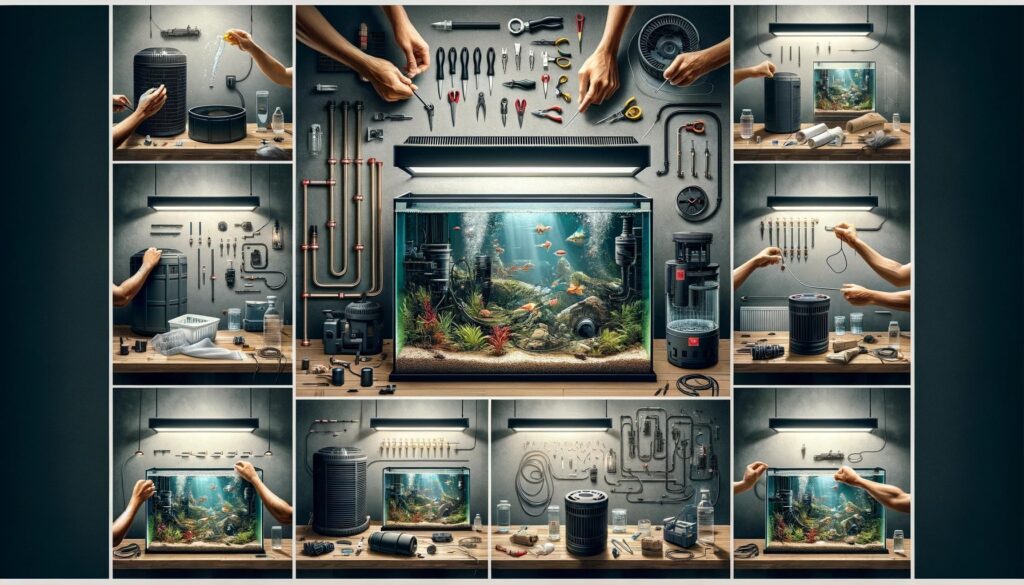
4. Filling Your Tank
After installing the equipment, it’s time to fill the tank with water. Use a clean bucket or hose, and add water slowly to avoid disturbing the substrate. Once filled, treat the water with a water conditioner to remove harmful chemicals like chlorine.
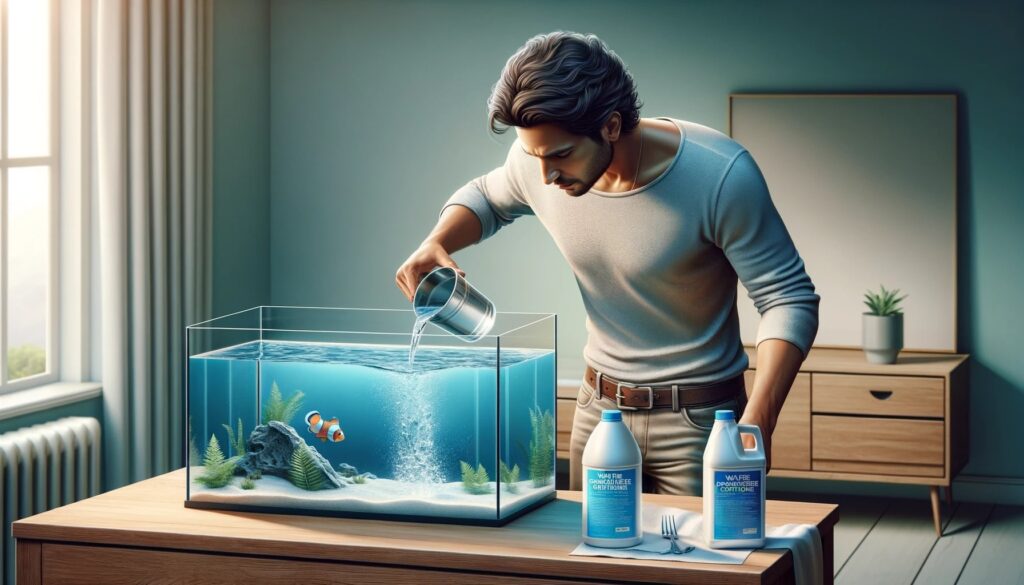
Setting up your aquarium can be a fun and rewarding experience. Remember, patience is key – let your tank stabilize for a few days before adding any fish
Cycling Your Aquarium
Cycling your aquarium is a crucial step in setting up a new tank, and it’s something I learned the hard way. It involves establishing a nitrogen cycle, a natural process vital for creating a healthy environment for your fish. Here’s a rundown of how I cycled my tank and why it’s so important.
Understanding the Nitrogen Cycle
The nitrogen cycle involves converting harmful substances like ammonia into less harmful ones, such as nitrate. This cycle is crucial because:
- Ammonia, produced from fish waste, is toxic to fish.
- Nitrite, the intermediate compound, is also harmful.
- Nitrate, the final product, is less toxic and can be managed with regular water changes.
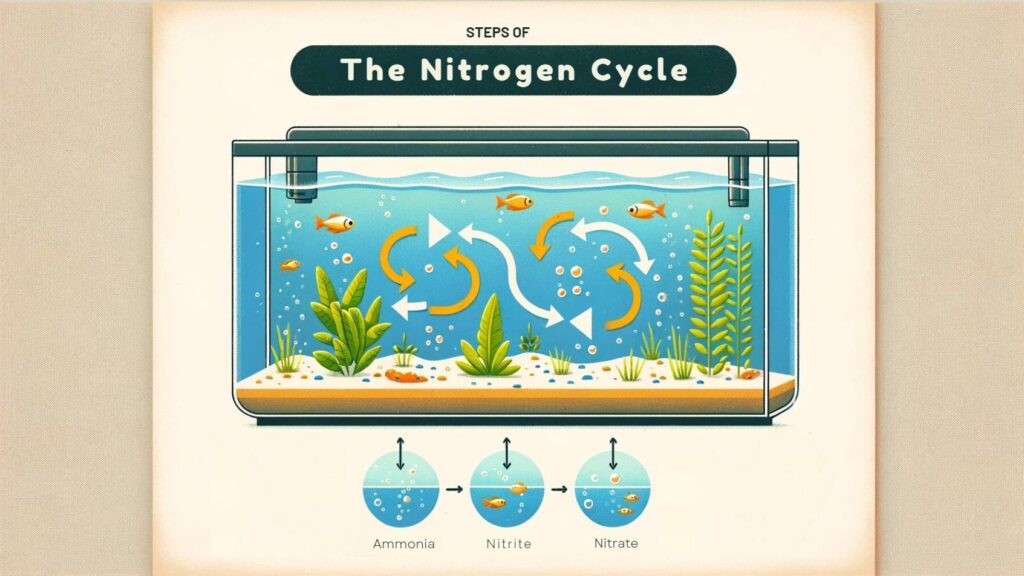
Steps to Cycle Your Tank
- Set Up Your Aquarium: Make sure your tank, filter, and other equipment are properly installed.
- Start the Cycle: Introduce ammonia to the tank. This can be done using fish food or specialized products.
- Monitor Water Parameters: Regularly test the water for ammonia, nitrite, and nitrate levels. A drop in ammonia and nitrite indicates the cycle is progressing.
Monitoring Water Parameters
It’s vital to frequently test the water. Here’s what to look for:
- Ammonia: Should initially rise, then fall to 0.
- Nitrite: Will increase as ammonia decreases, then should also drop to 0.
- Nitrate: This will start to appear as nitrite falls, indicating the cycle is near completion.
Role of Beneficial Bacteria
These bacteria are the heroes of the nitrogen cycle. They convert harmful substances into less harmful ones, creating a balanced environment. They grow naturally, but you can also introduce them through products.
Cycling your aquarium is a waiting game, but it’s essential for the health of your fish. Patience and regular monitoring will lead to a thriving aquatic environment.
This process taught me the importance of patience and attention to detail in aquarium care. Remember, a well-cycled tank is the foundation of a healthy aquatic home!
Aquascaping and Decorations
Choosing Live Plants vs. Artificial Decorations
When it comes to aquascaping, one crucial decision is whether to use live plants or artificial decorations. While live plants offer a natural environment and help maintain water quality by absorbing nitrates, they require specific lighting, substrate, and additional care. On the other hand, artificial decorations can be equally aesthetically pleasing and are easier to maintain. However, they don’t offer the same environmental benefits as live plants. For more information on the pros and cons of each, visit guide on plants and decorations.
Creating a Visually Appealing and Fish-Friendly Environment
A well-aquascape aquarium is not just about beauty; it’s about creating a habitat that supports the health and well-being of your fish. This involves a balance of open swimming areas and hiding spots. Open areas allow fish to swim freely, while hiding spots provide necessary refuge and reduce stress, especially for shy or territorial species.
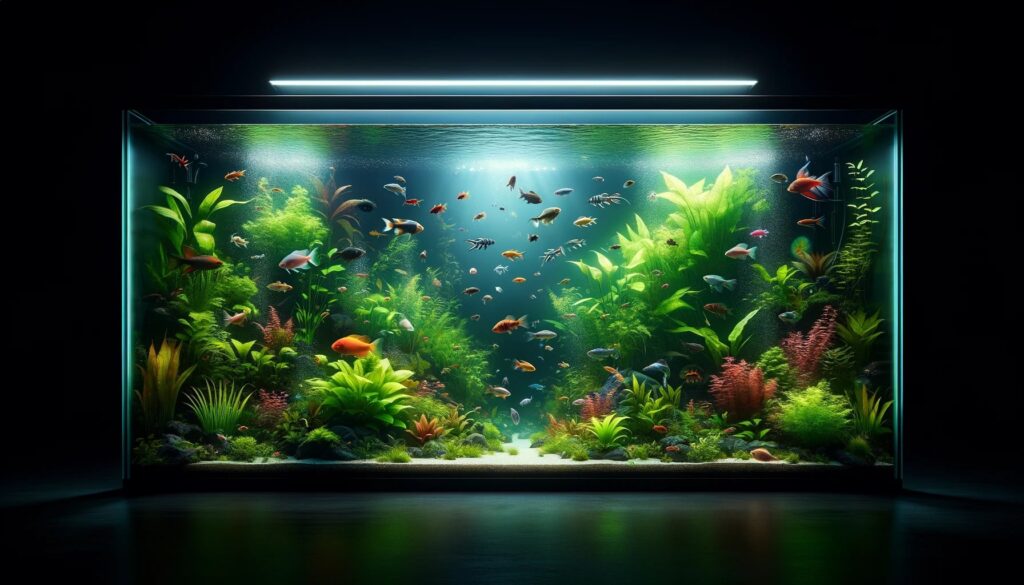
Importance of Hiding Spots and Open Swimming Areas
In your aquarium design, consider the natural behavior of your fish. Species like cichlids need ample hiding spots, which can be provided by caves or dense plantings. Conversely, active swimmers like Danios thrive in open spaces. To understand more about fish-specific needs, check out fish profiles.
Aquascaping is an art that balances aesthetics with the functional needs of your aquarium’s inhabitants. Whether you choose live plants, artificial decorations, or a combination of both, remember to cater to the needs of your fish while creating a visually appealing environment. For beginners and experts alike, aquascaping section offers comprehensive guidance to help you create your underwater masterpiece.
Selecting Your Fish
When it comes to setting up an aquarium, one of the most exciting parts is selecting your fish. But it’s not just about choosing the prettiest ones; there’s a lot to consider to ensure your aquatic pets thrive. Here are some essential tips I’ve learned along the way.
Understanding Fish Compatibility and Community Tanks
Creating a community tank is like putting together a puzzle. It’s crucial to understand which fish species can coexist peacefully. Some fish are naturally aggressive, while others are docile.
Tips for Choosing the Right Fish
- Research: Spend time learning about different fish species, their needs, and behaviors.
- Observe: At the store, watch how the fish interact with others. Are they aggressive or calm?
- Ask Experts: Don’t hesitate to ask for advice from the store staff or consult online resources like me 🙂 .
The Importance of Not Overstocking Your Tank
An overstocked tank can lead to numerous problems, including poor water quality and increased stress for the fish. To avoid this:
- Calculate Tank Capacity: Use a reliable guide from Oscar Fish Lover to determine how many fish your tank can comfortably hold.
- Consider Fish Size: Remember that small fish can grow. Plan for their full-grown size.
Quarantining New Fish
Before adding new fish to your main tank, it’s vital to quarantine them. This practice helps prevent the spread of diseases and allows you to monitor the new fish’s health in a controlled environment. For detailed steps on effective quarantine procedures, check out Quarantine Guide.
Quarantine Process
- Separate Tank: Use a separate tank for quarantining new arrivals.
- Monitor Health: Observe the fish for any signs of illness during the quarantine period.
- Gradual Introduction: Introduce the quarantined fish to the main tank gradually to reduce stress.
Selecting the right fish for your aquarium is a rewarding process. With the right knowledge and resources, you can create a harmonious and healthy aquatic environment. Remember, patience and research are key to a thriving aquarium community.
Maintaining Your Aquarium
I’ve learned that regular maintenance is key to a healthy aquatic environment. Let’s dive into the essentials of aquarium care.
Regular Maintenance Tasks
- Feeding: It’s vital to feed your fish a balanced diet. Overfeeding can pollute the water, so I follow a strict schedule. More on this at Feeding Schedules.
- Water Changes: I perform weekly water changes of about 15-20% to maintain water quality.
- Cleaning: This includes scrubbing the tank walls, vacuuming the substrate, and rinsing filter components.
Monitoring and Adjusting Water Parameters
Keeping track of pH, ammonia, nitrite, and nitrate levels is crucial. I use a reliable test kit weekly and adjust as needed. Poor water conditions can quickly lead to fish stress and disease.
Common Issues and Solutions
- Algae Control: Algae growth can be managed by controlling light exposure and nutrients in the water. I often use algae-eating fish or snails as a natural solution. Learn more at Algae Control.
- Cloudy Water: This is usually a sign of bacterial bloom or fine particulate matter in the water. I address this by enhancing filtration and ensuring proper tank cycling.
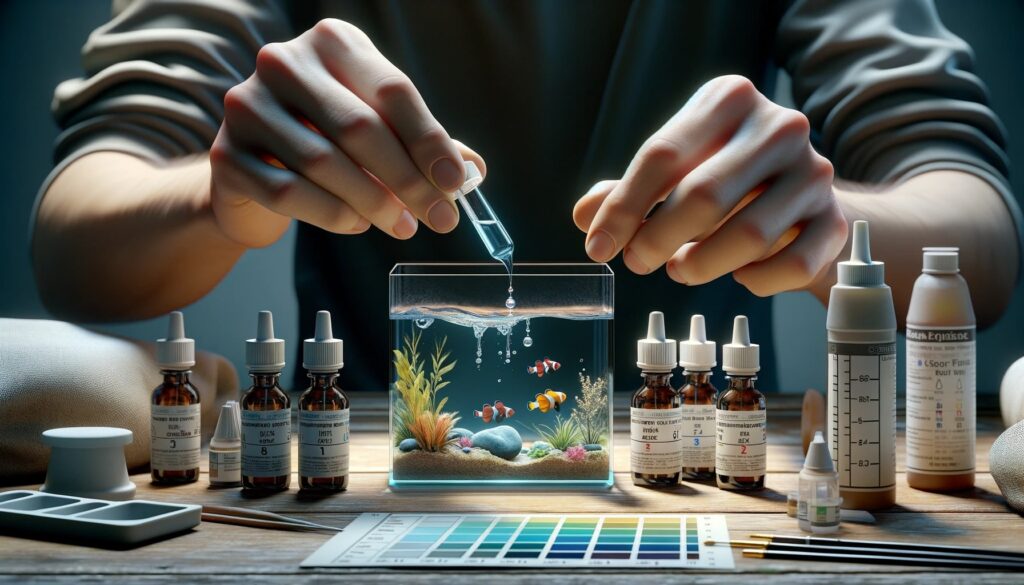
Consistent maintenance and monitoring are essential for a thriving aquarium. With the right approach, you can enjoy a vibrant and healthy aquatic ecosystem.
Table: Weekly Maintenance Checklist
| Task | Description |
|---|---|
| Feeding | Balanced diet, avoid overfeeding |
| Water Change | 15-20% weekly |
| Cleaning | Scrub walls, vacuum substrate, rinse filters |
| Water Testing | pH, ammonia, nitrite, nitrate |
Troubleshooting Common Problems
I’ve faced my fair share of challenges in maintaining a healthy aquarium. In this article, I’ll share my insights on identifying and addressing common fish diseases, managing water quality issues, and tips for solving equipment-related problems.
Identifying and Addressing Common Fish Diseases
Fish diseases can be daunting, but early identification is key. Here are some common ailments and their solutions:
- Ichthyophthirius (Ich): Look for white spots on your fish’s body. Raising the tank temperature gradually and using a recommended Ich treatment can help.
- Fin Rot: If the fins appear torn or ragged, improve water quality and consider antibacterial treatments.
For more on fish diseases, check out the detailed guides here.
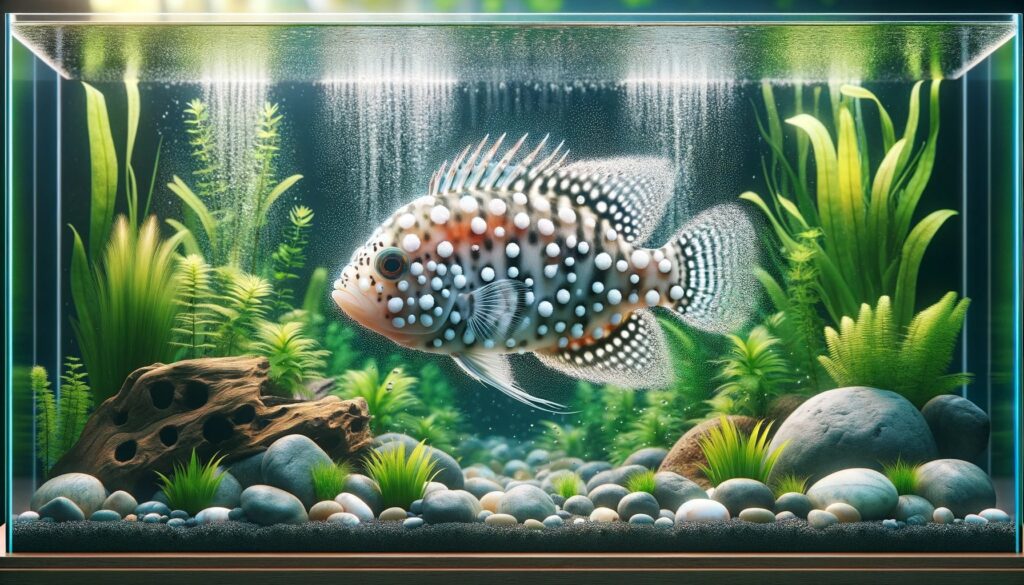
Managing Water Quality Issues
Water quality is the cornerstone of a healthy aquarium. Here’s how to manage it:
- Regular Testing: Use test kits to monitor pH, ammonia, nitrite, and nitrate levels.
- Water Changes: Perform regular water changes, about 20-30% weekly, to maintain balance.
Learn more about water quality testing and management.
Tips for Solving Equipment-Related Problems
Equipment failures can happen, but they’re often easy to fix. For filter issues, check for clogs or motor problems. Lighting systems should be regularly inspected for bulb efficiency. For an extensive review of aquarium equipment and maintenance, consider reading Aquarium Equipment Maintenance.
Table: Common Equipment Problems and Solutions
| Equipment | Problem | Solution |
|---|---|---|
| Filter | Clogging | Clean or replace filter media |
| Heater | Inaccuracy | Calibrate or replace |
| Lights | Dimming | Replace bulbs |
By being proactive and knowledgeable, you can ensure your aquatic pets thrive in a healthy, balanced environment. Remember, consistent care is the key to a flourishing aquarium!
Enjoying Your Aquarium
Watching the gentle sway of aquatic plants and the serene movement of fish provides a peaceful escape from the hustle and bustle of daily life. It’s not just a hobby; it’s a form of relaxation and meditation.
Learning and Growing with Your Aquarium
Each day with my aquarium is a learning experience. From understanding the intricate balance of the ecosystem to the specific needs of each fish species, there’s always something new to discover.
List of Learning Topics in Fishkeeping:
- Water Chemistry
- Fish Species Requirements
- Plant Care
- Aquascaping Techniques
Connecting with the Fishkeeping Community
One of the most rewarding aspects of fishkeeping is connecting with a community of like-minded enthusiasts. Whether it’s online forums, local aquarium clubs, or social media groups, the fishkeeping community is a treasure trove of support, advice, and shared experiences. Engage with fellow aquarists at Oscar Fish Lover’s Community to start your social journey in the aquatic world.
Fishkeeping is more than just a hobby; it’s a journey of discovery, learning, and connection. By embracing the calming beauty of your aquarium and engaging with the community, you can enjoy a deeply rewarding and enriching experience.

